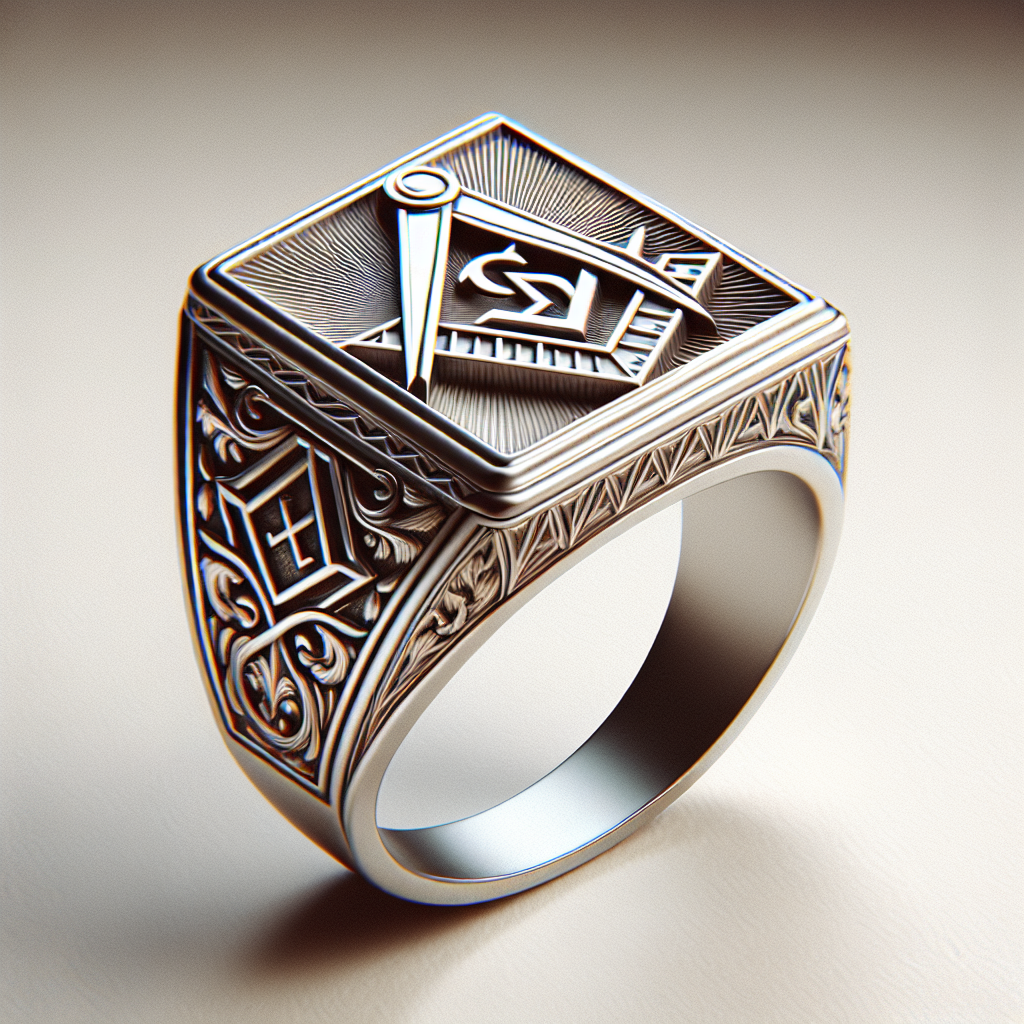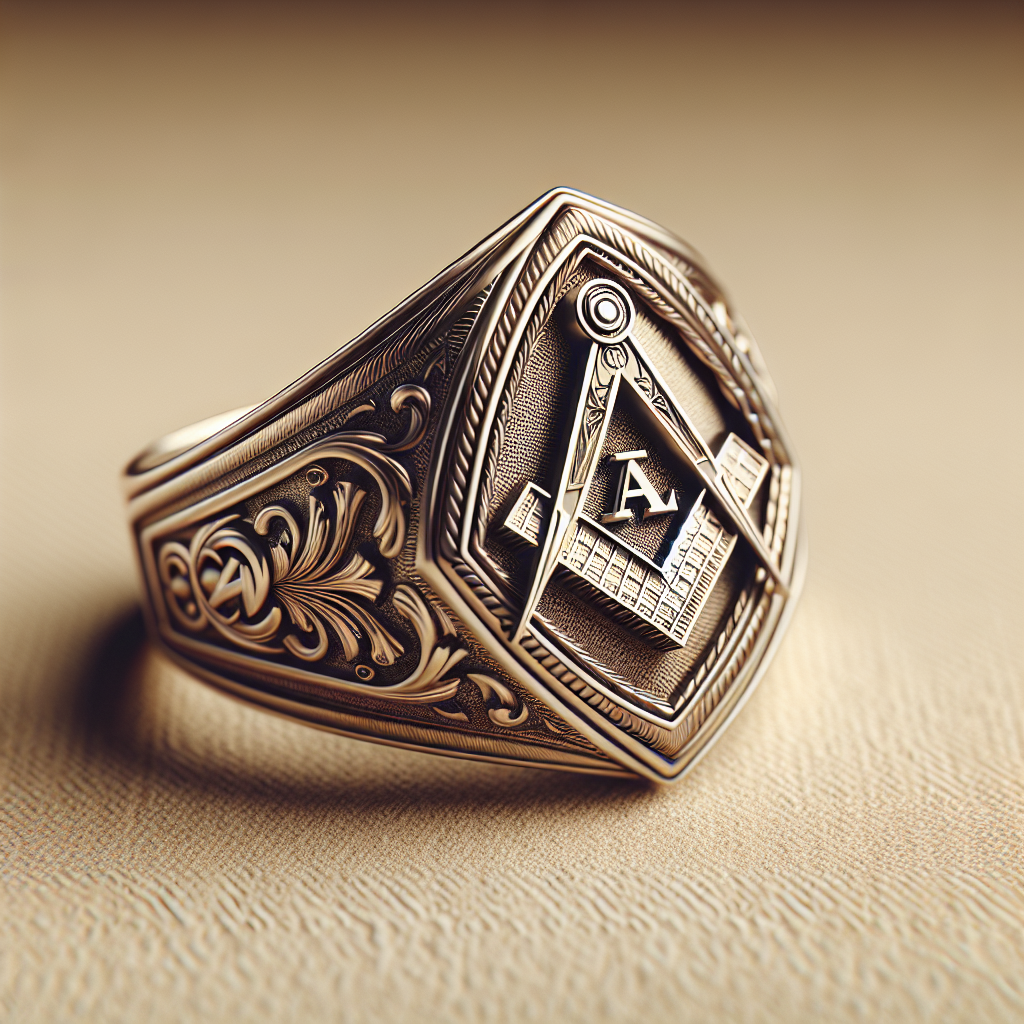
You may be eager to understand the aesthetics of Masonic rings, those historic and loaded emblems representing Free Masonry’s rich heritage. This article will be your flashlight, illuminating each cranny and nook of these rings – from their intricate designs, secretive symbols to their unmistakable craftsmanship. Come along on this fascinating journey as you immerse yourself in gaining knowledge about the looks and significance of Masonic rings. Let’s decode together the visual language hidden within these emblematic adornments!
Definition of Masonic Rings
Masonic rings are pieces of jewelry that are representative of a membership or affiliation to the Masonic Fraternity, an international secret society. These rings often feature intricate designs and engravings denoting symbols and emblems specific to Freemasonry, and each design element is entrenched with historical significance and meaning.
Understanding Freemasonry
Freemasonry is unity presented in the form of a fraternal society. It appears as a network of lodges stretching across the globe, and membership is composed of individuals seeking philosophical teachings and camaraderie. Freemasonry often involves mysterious ceremonies, charitable activities, and modes of symbolic recognition—including the use of Masonic rings.
Origins of Masonic Rings
The origins of Masonic rings trace back to a time when the Freemasons were operative masons – the workers who laid stones and built cathedralss. The “mark” was an early form of a Masonic ring, a unique engraving used by each mason on the stones they chiseled. In today’s symbolic form, the Masonic ring represents a Mason’s commitment to uplift and better themselves and the fraternity.
Significance of Masonic Rings
A Masonic ring is more than just a piece of jewelry; it’s a signal of one’s affiliation, brotherhood, and commitment to the Masonic fraternity’s principles. The designs are intricate and symbolic, each component has its own unique implication that speaks of the wearer’s Masonic journey and philosophies.
General Appearance of Masonic Rings
Shape and Size
Masonic rings come in various shapes and sizes depending on the wearer’s preference. Most commonly, they have a prominent central section, often square or rectangular, which features the Masonic emblem. The band is typically thick and masculinity, reflecting the fraternity’s nature.
Materials Used
The most commonly used materials to craft Masonic rings are gold, silver, and stainless steel. However, some can be crafted from bronze, copper, white gold, or even platinum. The choice of material often reflects the wearer’s personal taste and the value they assign to this indication of their Masonic journey.
Popular Color Schemes
The popular color scheme for Masonic rings tends to rely on the classic contrast of silver or gold mixed with strikingly deep hues such as black or deep blue. These contrasts often bring the symbolic emblems and engravings to life, enhancing their visibility and overall charm.

Emblems and Symbols on Masonic Rings
All Seeing Eye
The All-Seeing Eye, also known as the Eye of Providence, is a prominent and popular symbol in Masonic iconography. On a Masonic ring, it signifies omnipresent vigilance, divine watchfulness, and spiritual insight.
Square and Compass
The Square and Compass is the most internationally recognized emblem of Freemasonry. The Square symbolizes righteousness and virtue while the Compass represents equipollence and wisdom. On a Masonic ring, it’s typically positioned centrally.
Pillars
The Pillars symbolize Solomon’s legendary temple and Masonic teachings between birth and death and everything in between. In regards to a Masonic ring, the presence of pillars can denote the wearer’s belief in strength, establishment, and creating something meaningful in life.
Trowel Symbol
The Trowel represents the work done by Masons in their personal lives and communities to foster unity and betterment. When this symbol appears on a Masonic ring, it symbolizes the wearer’s dedication to this cause.
Ashlar Symbols
The Rough and Perfect Ashlar are symbolic tools representing self-improvement from a rough, unrefined state to a perfected state. The appearance of ashlars on a Masonic ring signifies the wearer’s commitment to self-betterment.
The Square and Compass Symbol
Meaning of the Square and Compass
The Square and Compass symbolize a Freemason’s need for morality and boundary of action and thought. The Square stands for fairness, balance, stability, giving us a sense of duty and righteousness. The Compass, on the other hand, symbolizes wisdom, intelligence, and vision.
Design and Placement on the Ring
The design of the Square and Compass on a Masonic ring varies, but it is often overlapping, with the square below and the compass above. Positioned centrally, it typically dominates the design, emphasizing its importance in Freemasonry.
Variations in Square and Compass Symbols
Though the basic design of the Square and Compass does not have many variations, the included elements between these symbols may differ. These may include the letter ‘G’ – for God or Geometry, the All-Seeing Eye, or the Sun.

Interpreting Color Schemes of Masonic Rings
Meaning of Common Colors
In Freemasonry, different colors hold different meanings. Blue is considered to symbolize universal brotherhood and friendship, white denotes purity and innocence, and red signifies fervency and zeal.
Role of Colors in Masonic Symbolism
In the context of Masonic rings, colors enhance the symbol’s visibility and add an additional layer of meaning. They help in interpreting the ring’s message and reflecting the personal choices of the wearer.
Variations in Color Schemes
Masonic rings may exhibit variations in color schemes to reflect the rank or affiliation of the wearer, or simply personal preference. For example, gold is often associated with higher ranks within the fraternity, while silver or stainless steel could be more typical of lower ranks.
Significance of Materials Used
Gold Masonic Rings
As a globally recognized symbol of wealth, wisdom, and illumination, gold is quite popular as a material for Masonic rings. It often signifies someone of higher rank as gold is historically associated with divinity and power.
Silver Masonic Rings
Silver implies purity and clarity. Silver Masonic rings are popular given their timeless look and the flexibility of silver to be molded into intricate designs. They convey the wearer’s purity of purpose within the fraternity.
Stainless Steel Masonic Rings
Stainless steel represents durability and strength. Stainless steel Masonic rings are both contemporary and durable, offering a sleek aesthetic. These rings signal the bearer’s endurance, virtue, and reliable character.
Role of Materials in Masonic Values and Traditions
The choice of material in a Masonic ring is not merely aesthetic; it echoes the values and traditions of Freemasonry. Gold, silver, and stainless steel each bring forward a connotation – all of which emphasize the guiding principles of Freemasonry including love, relief, and Truth.

Role of Masonic Rings within Freemasonry
Symbolism and Mentorship
Masonic rings are greatly symbolic within the society. They carry lessons and reminders of the spiritual growth a Mason aims for. Often, senior Masons mentor juniors on the interpretation of these symbols.
Designating Ranks and Titles
In some instances, the design of a Masonic ring may help identify the wearer’s rank or title within the Masonic fraternity. Higher-ranking members often have specific symbols and materials that may differ from those of the lower ranks.
Declaration of Loyalty and Brotherhood
Simply wearing a Masonic ring serves as a declaration of belonging and commitment to the principles of Freemasonry. It signifies the bond between a Freemason and his fellow brothers, symbolizing strength, honor, and fidelity.
Modern Interpretations of Masonic Rings
Contemporary Designs
Contemporary designs of Masonic rings blend tradition with modern jewelry trends, leading to a broader variation in the rings’ appearance. These new designs cater to younger members who want to uphold their affiliation in a more modern, stylish manner.
Influence of Pop Culture
Pop culture has magnified the curiosity around Masonic rings as they are often featured in movies, TV shows, and even music videos. As a result, the design and representation of these rings have evolved to appeal to a broader demographic and changing tastes.
Fusion with Modern Jewelry Trends
The fusion of Masonic symbols with modern jewelry trends has led to the transformation of Masonic rings into fashion-forward, statement pieces, making them more attractive to the younger generation while still retaining their symbolic significance.

Purchasing and Care of Masonic Rings
Where to Purchase Masonic Rings
Masonic rings can typically be purchased from jewelers specializing in Masonic jewelry. Many online options also exist to cater to different preferences and styles.
How to Care for Masonic Rings
To maintain their longevity, it’s recommended to regularly clean your Masonic rings with mild soapy water and a soft bristle brush. Also, storing them in a cool, dry place when not in use will help prevent damage and discoloration.
Meaning Behind Gifting a Masonic Ring
Gifting a Masonic ring is often an indication of respect and a form of celebration. The ring can be a significantly meaningful present when marking a milestone or achievement within the fraternity.
Masonic Rings in Pop Culture and Society
Depictions in Movies and TV
Masonic rings have intrigued makers of movies and TV shows alike. They often appear as powerful symbols of association and influence.
Famous Personalities Wearing Masonic Rings
Celebrity Freemasons, including famous politicians, actors, and musicians, often proudly flaunt their Masonic rings, contributing to their widespread fascination.
Public Perception and Controversy
Public perception around Masonic rings is as diverse as the fraternity itself. Some view them as mysterious and intriguing, while others see them as controversial. Despite differing opinions, there’s no denying the iconic standing of Masonic rings in jewelry history and fraternal symbolism.












